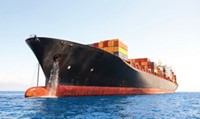Advertisement
Grab your lab coat. Let's get started
Welcome!
Welcome!
Create an account below to get 6 C&EN articles per month, receive newsletters and more - all free.
It seems this is your first time logging in online. Please enter the following information to continue.
As an ACS member you automatically get access to this site. All we need is few more details to create your reading experience.
Not you? Sign in with a different account.
Not you? Sign in with a different account.
ERROR 1
ERROR 1
ERROR 2
ERROR 2
ERROR 2
ERROR 2
ERROR 2
Password and Confirm password must match.
If you have an ACS member number, please enter it here so we can link this account to your membership. (optional)
ERROR 2
ACS values your privacy. By submitting your information, you are gaining access to C&EN and subscribing to our weekly newsletter. We use the information you provide to make your reading experience better, and we will never sell your data to third party members.
Environment
A One-Two Punch To Block Invasive Species From Entering Freshwater Ports
Water Management: Canadian scientists propose strategy to stop the spread of foreign organisms carried by cargo ships
by Louisa Dalton
January 17, 2013

As cargo ships move port to port, aquatic plants and animals hitch a ride, travelling from their native ecosystems to new ones. When the organisms arrive, they can multiply quickly, disrupting the new ecosystems and leading to extinctions of native species. Now Canadian scientists report a potentially effective two-prong method for preventing these hitchhikers from entering freshwater ports (Environ. Sci. Technol., DOI: 10.1021/es3029445).

Freshwater lakes like the Great Lakes are especially hard-hit by exotic intruders, says Sarah A. Bailey, a research scientist at Fisheries and Oceans Canada, a government agency. For example, round gobies (Neogobius melanostomus), a salt-tolerant fish from the Caspian Sea, compete with native Great Lakes perch for food.
Ships often pick up these invasive organisms, sometimes as eggs or larvae, via the water in the vessels’ ballasts. At ports, ships pump water in or out of their ballasts to compensate for the weight of cargo unloaded from or loaded onto the vessel.
Since the early 1990s, Canada and the U.S. have required ships crossing oceans to exchange ballast water at sea before arriving at the Great Lakes. Potential invaders picked up at a foreign freshwater port are far less likely to survive in the briny water brought on during these exchanges.
The International Maritime Organization (IMO) has proposed replacing the ocean water exchange method altogether with a ballast water treatment process that would reduce the total number of plants and animals in the ballast water by filtering, sterilizing, or chemically treating the water.
But Bailey and other scientists worry that by dropping the salt water exchange step, ships headed toward freshwater ports will lose an effective tool in blocking invasive species: the salinity barrier.
So Bailey and scientists from the U.S. and Canada wanted to test whether combining ballast water exchange with the proposed treatment process was better at eliminating unwanted organisms than treatment alone.
The scientists filled two elevator-sized ballast tank replicas with water from a Lake Superior harbor. They treated one tank as a ship might under the proposed ballast water treatment process. As they filled the tank, the team ran the water through a commercially available treatment system that filtered the water and then used free radicals generated by ultraviolet light to kill any living cells.
In the other tank, the researchers tested the combination method. They replaced 80% of the harbor water with synthetic ocean water—water combined with a whole lot of aquarium salt.
After about 20 hours, the team then discharged the water from each tank to simulate a ship pumping out its ballasts. As water flowed out of both, it went through the commercial treatment system’s free radical step. As a result, one tank’s harbor water experienced two treatment steps, while the other’s water had an exchange step and a treatment one.
During and after the trials on both tanks, the scientists took samples of the water and looked under a microscope for living organisms, including plankton with a diameter larger than 50 µm.
Treatment without salt water exchange reduced the amount of living plankton in the tank by 98.61%. But the combination approach cut numbers by 99.99%. The number of organisms remaining in the tank after the treatment-only process did not meet current proposed IMO standards.
Combining ballast water exchange with water treatment “has been talked about for years and years,” says oceanographer Fred C. Dobbs at Old Dominion University. Yet this study is the first attempt at actually testing the idea, Dobbs says, and the data justify further testing onboard ships. From an ecological perspective, he says, “the more organisms that can be removed, the better.”




Join the conversation
Contact the reporter
Submit a Letter to the Editor for publication
Engage with us on Twitter